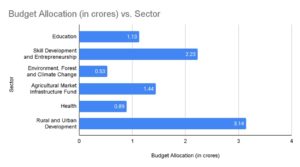“Reform, Reform, Reform” – The Mantra of Amrit Kaal outlines several key reforms aimed at boosting and opening doors to; certainly hitting the bullseye i.e. the growth of India’s economy in the next 25 years.
The Finance Minister ‘Nirmala Sitharaman’ has now set the pace forth with the Saptarishi i.e. the 7 principle economic priorities including inclusive development, the promotion of green growth, youth power, Infrastructure and investment, Unleashing the potential, reaching the last mile and financial sector; under the Amrit Kaal Budget 2023.
Amrit Kaal, translating to “forward movement towards independence” has gained traction and been enshrined in the Budget 2023. It aims to be a promising harbinger of India’s economic future, offering a roadmap for the country’s self-reliance and sustainable development. To the advocates, it looks like a well-calculated attempt to put India on the path to prosperity and growth.
And as the story of Amrit Kaal unfolds, it’s worth asking: what will the future look like for India’s economy?
Well, the numbers speak for themselves? According to economic experts, with the right initiatives in place, India’s economy is expected to reach a total size of US$26 trillion and its per capita income is expected to cross US$15,000 by 2047! This year, as of 2023, the Indian economy is to reach a nominal GDP of US$3.3 trillion, while its per capita income is to reach US$ 2,967.
Additionally, the Finance Minister has also claimed that the country is expected to see a GDP growth of 7% this year, as maintaining its position to strive in as a big economy. With this in order, the country will lead to a more equitable society, reducing the gaps between different socioeconomic classes.
But how exactly will “Amrit Kaal Budget” make this happen?
The idea of the “Amrit Kaal” is to drive India on a path of “Atmanirbhatta” i.e. a self-reliant economy, a concept that will shape the country’s economic future in a way that no initiative or program could ever do on its own.
While India’s economy continues to thrive, the central government’s capital expenditure, which rose 63.4% in the first eight months of FY2023, has also driven the economy and attracted private investment. In total, investment projects in the first nine months of 2022-23 reached INR 21 lakh crore, a 53.2% increase from the previous year.
The 2023-24 budget target of INR 10 lakh crore ($122 billion), a 33% increase, will likely be met. The government will also provide INR 1.3 trillion in loans for states to make longer-term investments.
Let’s see some of the major budget allocations for 2023 to understand the ambit of the said purpose:

Source: www.indiabudget.gov.in
As what the above chart represents along with the relevant data, India’s Amrit kaal budget gives a big nod to “green” and “sustainable”, and some of the takeaways from the allocation that nurtures the very vision of the country are:
- The whooping allocation to education, skill development and entrepreneurship indicates that the government wants to equip the future workforce with the necessary skills and knowledge to drive the country forward.
- The allocation for higher education in the latest budget has seen a significant boost, with an increase of 8.26% compared to the previous budget. This translates to a total allocation of Rs. 44,094 crore, marking a 7.9% rise from last year’s allocation.
- The allocation to Environment, Forest and Climate Change, reiterates the government’s commitment to preserving the environment for future generations.The setting up of a new agricultural market infrastructure fund of ₹1 lakh crore is aimed to help strengthen and expand agricultural market infrastructure. This fund will give a much-needed boost to India’s agricultural sector and help it to become more competitive in the global market.
- The significant allocation towards healthcare with a staggering amount of ₹88,956 crore, marks a 2.71% increase from the previous budget. Additionally, as per reports, this allocation emphasizes the importance of eliminating Sickle Cell Anemia and launching 157 new nursing colleges, indicating a strong commitment to improving the health and well-being of citizens.
- Subsequently, as per data, the Amrit Kaal Budget has allocated Rs.1.18 lakh crore to build infrastructure for digital libraries at the panchayat level, Rs.1.6 lakh crore for the Ministry of External Affairs, Rs.5.5 lakh crore to encourage personal savings in the developing country, aiming to the overall gambit.
Well, that’s not all!
India is on the cusp of an exciting and transformative time as it aims to reach $26 trillion in economic prosperity in the “Amrit Kaal”. This growth will not only impact the nation internally, but also project India as a thriving global power. Besides, the Make in India campaign is playing its part in the Amrit Kaal story, fueling growth and generating employment through an influx of foreign direct investment (FDI). The program has already seen a remarkable 43% surge in FDI inflows in just two years, demonstrating its effectiveness.
As an added bonus, the Amrit Kaal Budget aims to bring about a revolution in tax policy, by sweetening the deal for citizens with an increased tax rebate to Rs 7 lakh and a boosted exemption limit of Rs 3 lakh in the new tax regime. These measures are aimed at revving up personal savings and driving economic growth forward.
All in all, the essence of the Amrit Kaal Budget suggests it to be a primitive step in the country’s “Amrit Kaal” vision to unleash a flurry of opportunities for citizens, particularly the youth, while propelling growth to new levels. It also lays a strong foundation for macro-economic stability, with a focus on empowering women in the 2023 budget. The goal is to catapult women’s self-help groups to the next level of economic might, by providing them with the necessary raw materials, branding and marketing support to turn their dreams into realities.
Also Read: Examining the Role of Jan Bhagidari in Shaping the Union Budget 2023

